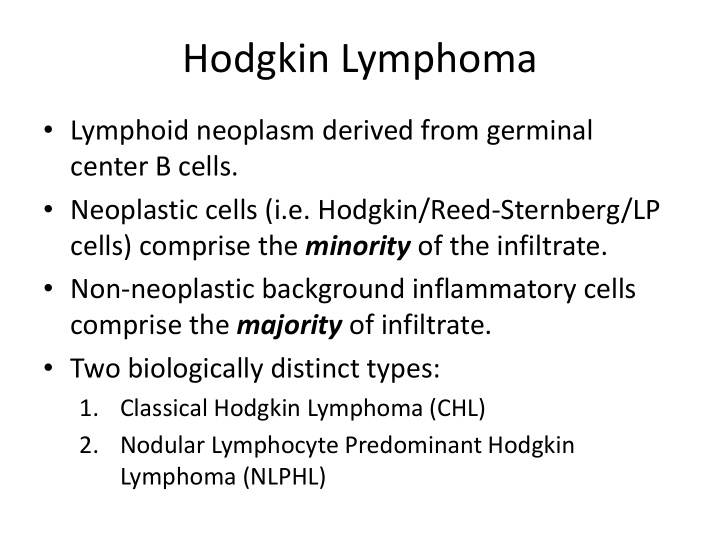



Hodgkin Lymphoma • Lymphoid neoplasm derived from germinal center B cells. • Neoplastic cells (i.e. Hodgkin/Reed-Sternberg/LP cells) comprise the minority of the infiltrate. • Non-neoplastic background inflammatory cells comprise the majority of infiltrate. • Two biologically distinct types: 1. Classical Hodgkin Lymphoma (CHL) 2. Nodular Lymphocyte Predominant Hodgkin Lymphoma (NLPHL)
Classical Hodgkin Lymphoma • Neoplastic B (Hodgkin) cells are often take the form of Reed-Sternberg cells or variants – Classic RS, mummified and lacunar cells. • The majority of background, non-neoplastic small lymphocytes are T cells. • Unique immunophenotype that differs from most B cell lymphomas. • Divided into 4 histologic subtypes according to the background milieu: Nodular Sclerosis – Mixed Cellularity – Lymphocyte Rich – Lymphocyte Deplete –
CHL - RS Cell Variants Classic RS Cell Lacunar Cells Mummified Cell Hsi ED and Golblum JR. Foundations in Diagnostic Pathology: Hematopathology. 2 nd Ed. 2012
CHL - Immunophenotype CD45 CD3 CD20 Pax-5 CD30 CD15
CHL - Histologic Subtypes
Nodular Sclerosis • Architecture is effaced by prominent nodules separated by dense bands of collagen . • Mixed inflammatory infiltrate composed of T cells, granulocytes, and histiocytes. • Lacunar variants are the predominant form of RS cells.
Mixed Cellularity • Architecture is effaced by a more diffuse infiltrate without bands of fibrosis . • Background of lymphocytes, plasma cells, histiocytes and eosinophils. • Approximately 75% of cases are positive for EBV -encoded RNA or protein (LMP1)
Lymphocyte Rich Architecture is effaced by a nodular to • vaguely nodular infiltrate of lymphocytes . Nodules may contain regressed • germinal centers. The majority of background, non- • neoplastic lymphocytes are B cells ; T cells form rosettes around neoplastic cells. Granulocytes and histiocytes are rare. • Regressed germinal center
Lymphocyte Deplete • Architecture is effaced by disordered fibrosis and necrosis. • Paucity of background inflammatory cells . • RS cells are characteristically pleomorphic and may be rare or abundant. Hsi ED and Golblum JR. Foundations in Diagnostic Pathology: Hematopathology. 2 nd Ed. 2012
Nodular Lymphocyte Predominant Hodgkin Lymphoma • Nodal architecture is effaced by large nodules with residual germinal centers compressed toward the periphery. • Neoplastic B cells take the form of LP or “popcorn” cells. • The majority of background, non-neoplastic lymphocytes are B cells; T cells form rosettes around neoplastic cells. • Immunophenotype reflects maintenance of the B cell repertoire.
Follicular dendritic meshwork is expanded imparting the nodular pattern. CD21
NLPHL – LP Cells “Popcorn” Cell
CD20 Neoplastic cells are positive and • rimmed by negative T cells Most of the background lymphocytes • are B cells “Moth-eaten” appearance on low • power
NLPHL - Immunophenotype CD3 Pax-5 EMA CD30
Recommend
More recommend